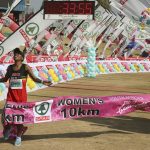Caster Semenya: ‘I try to do crazy stuff’
The two-time Olympic gold medalist is showing her impressive range by shifting to sprint events while she fights World Athletics to run the 800m without taking hormone-suppressing medication.
Author:
30 March 2020

The eulogy for Caster Semenya’s track career was all but written when World Athletics delivered a lethal blow by introducing its controversial female eligibility rules in 2019. Semenya vowed to continue her fight, appealing against the ruling by the Court of Arbitration for Sport (CAS) in favour of the global athletics body.
But the latest setback seemed to crack open the veneer of what was considered Semenya’s unbreakable spirit. She announced that she would take up football with her career in limbo and her fate on the track resting in the hands of the Swiss Supreme Court.
Secretly plotting her comeback, Semenya ventured into unfamiliar territory, making the transition from once-in-a-lifetime middle-distance athlete to start-up sprinter. Rumours started floating around as far back as October 2019 that Semenya was doing speed work, suggesting she was flirting with the idea of dropping down in the distance instead of going up to be eligible to compete in World Athletics-sanctioned events.
Semenya had already demonstrated she could move up in distance with relative ease after winning the 1 500m bronze medal at the London 2017 World Championships. Graduating to the 5 000m was the logical next step. She won the national title in Germiston in 2019 while she had also intimated she would one day target marathon running.
Related article:
The move is classic Semenya audacity and a reminder of how her circumstances have shaped her into a sports freedom fighter of sorts.
She opened the 2020 season by setting a new South African 300m best at an exhibition meeting at the University of Johannesburg, clocking 36.78s seven months after her previous race. The time was no surprise considering Semenya holds the national 400m record of 49.62s that she set in Ostrava in Czechia, formerly the Czech Republic, in September 2018.
She signalled that she could make the transition to the sprint events by chopping 0.24s off Heide Quinn’s national 300m mark that had stood for nearly two decades.
Biggest challenge of her career
The 29-year-old is showing an unprecedented range, boasting national bests and records in the 300m, 400m, 600m, 800m, 1 000m and 1 500m. Semenya once again announced herself as the potential fly in World Athletics’ ointment at the Gauteng North Championships in Pretoria on Friday 13 March.
The two-time Olympic 800m champion sliced 0.32s off her 200m personal best, winning the provincial title in a time of 23.49s. She would have to knock 0.69s off this time to meet the Olympic qualifying standard of 22.80s.
Semenya has admitted that she faces possibly the biggest challenge of her career, as the gamble could end in complete failure. But one could argue that even if Semenya does not succeed in replicating her achievements in the middle distances, she remains a defiant figure that World Athletics is unable to shake.
“The challenge is on and the main goal is nationals, where I will try to win the title,” a leaner-looking Semenya said after the race.
“I try to do crazy stuff. You run and win titles from 200m to 5 000m, no one has ever done that in the sport. I am trying to make history and break records, even though I know it is difficult to run these times. But I am up for it.”
Related article:
While Semenya still talks a big game, which in the past she could back up with stellar performances, she is now in uncharted territory.
Only eight women in the history of South African athletics have run faster than the Olympic-qualifying time of 22.80s. These were all pure-bred sprinters, including the likes of Geraldine Pillay and national record holder Evette de Klerk (22.06s). Athletics SA proposed even more stringent criteria; she has to post a time of 22.65s or faster to earn her place for her third Olympic Games, which Japan will now host in 2021 rather than in July as planned.
Clinching the national title is a different story considering the accelerated improvements in her times. She has gone from a personal best (PB) time of 24.26s in 2019 to taking 0.77s off that time a year later on the same track. These times represent a 3% improvement.
Her new PB of 23.49s would have been good enough to earn the national title in 2019, but last year’s final was considered sub-par compared with previous championships. The national half-lap sprint finals between 2013 and 2019 were dominated by Olympians Justine Palframan and Sevens convert Alyssa Conley. Three out of the six titles between them were won in times faster than 23 seconds.
Sights on Europe
While Semenya should be able to secure a few lanes at low-key meetings on the European circuit, she would have to dip well below 23 seconds to challenge the top women in the world.
“Racing in the European season is the goal. I’ve already registered the time, 23.5s is what most of the girls run on the circuit,” Semenya said.
“I don’t care about the big races because I am still new [in the 200m] and the more I improve and run better times, and I will get better competition.”
Related article:
If Semenya makes it to the Olympics, she would have to run considerably faster than she does at the moment.
Ecuador’s Ángela Tenorio was the slowest qualifier into the 200m semifinals at the 2016 Olympic Games in Rio de Janeiro, Brazil, with a time of 22.94s. It is even tougher to earn a place in the final considering that British sprinting sensation Dina Asher-Smith scraped through by the skin of her teeth with a time of 22.49s.
During her huddle with local journalists following her win at the Gauteng North Championships, Semenya frequently included the caveat that she faced a challenge of epic proportions.
Related article:
Winning seems to have come easy for Semenya since she raced to her maiden world 800m title at the 2009 Berlin World Championships, where the global gaze was fixed on the young athlete. She has amassed an impressive list of accolades, including 2012 and 2016 Olympic gold medals, two more world titles in 2011 and 2017, and the 1 500m bronze.
Semenya was making steady progress, inching ever so closely to the global 800m record before World Athletics pulled the handbrake on her career. She clocked the fourth-fastest time ever over the two-lap race at the Paris Diamond League meeting at the end of June 2018, setting a new national record of 1:54:25. Her time is nearly a second off Czech athlete Jarmila Kratochvílová’s world record of 1:53:28, which she set in Munich in 1983.
Long battle with World Athletics
Both the expert and the uninitiated predicted that Semenya would eliminate the dust-covered 800m world record after her remarkable run in 2009.
This narrative played into the fears that athletes like Semenya with differences of sexual development (DSDs) would dominate the sport. The majority of DSD athletes come from the Global South, which adds to the conspiracy theory that the regulations have a racial undertone.
Semenya’s performances would remain under the spotlight. If she ran measured, race pundits would say she was holding back. If she produced a stunning time, it was the testosterone giving her the oomph. She has been damned either way.
It happened at the 2012 Olympic Games in London, England, where she finished second behind Russian doping offender Mariya Savinova. Semenya’s silver medal has since been upgraded to gold because of Savinova’s indiscretions.
The past two years have seen Semenya and her legal experts take on World Athletics over its disputed research, which claims she has an unfair advantage over other female athletes. Semenya has been the only DSD athlete to challenge the new regulations.
Related article:
The move to go down in distance could paint the organisation into a corner. World Athletics added terms to the regulations that would allow it to expand or narrow the restricted events – track events run over distances between 400m to one mile.
Semenya remains unflappable in the face of the challenge, relishing the chance to strike fear in the hearts of World Athletics’ decision-makers.
“You know me, I will always challenge myself. This wasn’t an easy decision to make because you are used to running two laps, and then you come and run half a lap,” Semenya said. “You have to adjust to the programme. It has not been easy, but anything is possible. Anything you plan, you can do.”
Related article:
Semenya, who relied heavily on her natural rhythm in the 800m, would have to forego finesse in favour of brutal power and speed. She would characteristically trot for a lap and a half in her specialist event before unleashing a brutal kick over the final 200m of a race.
“I come from endurance going into speed. I am a power athlete and now my focus is on biomechanics, now it is all about strength and power and speed,” she said.
“I was born with sprints. With the conditions I grew up in Limpopo, I didn’t have a coach and I had to decide to go to middle distance,” Semenya said.
“The 200m really isn’t a challenge, the challenge is how to do it [right]. You have to master a lot of things. You have to start quick, you have to slip on the bend and you have to keep high knees. It is crazy, but I am enjoying it. I enjoy running 200m. I wish I had run 200m from age 12. Imagine where I could have been now.”






